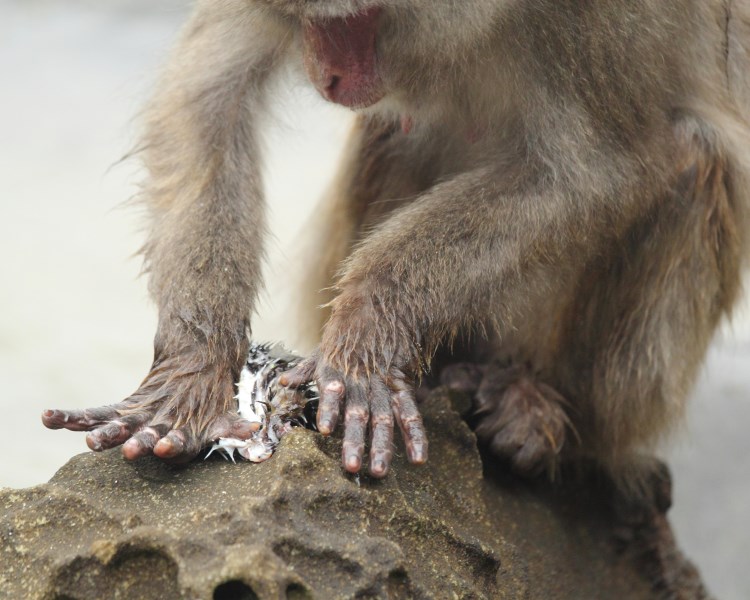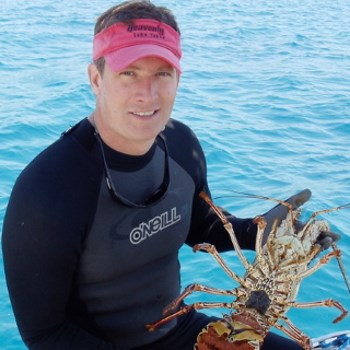Links to external sources may no longer work as intended. The content may not represent the latest thinking in this area or the Society’s current position on the topic.
Evolution of pathogen and parasite avoidance behaviours

Theo Murphy international scientific meeting organised by Dr Rachel McMullan and Cecile Sarabian
Avoidance behaviours protect species as diverse as worms, ants, fish, monkeys and humans from infection by reducing or preventing contact with parasites and pathogens. This meeting will unite researchers working in invertebrates, vertebrates and humans to discuss the evolution of pathogen avoidance behaviour and how these avoidance instincts can be harnessed to improve animal and human health around the world.
The schedule of talks and organiser and speaker biographies are available below.
Attending this event
This meeting has taken place.
Recorded audio of the talks is available below. Meeting papers will be published in a future version of Philosophical Transactions B.
Enquiries: Contact the Scientific Programmes team
Organisers
Schedule
Chair

Dr Rachel McMullan, The Open University, UK

Dr Rachel McMullan, The Open University, UK
Rachel McMullan studied biochemistry and molecular biology at the University of Birmingham. She obtained her PhD in 2003 working in the laboratory of Neil Hotchin at the University of Birmingham and studying the regulation of keratinocyte function by small GTPases. Between 2003 and 2009 Rachel worked as a postdoc in Stephen Nurrish’s labortatory in the MRC Laboratory for Molecular Cellular Biology at University College London. During this period Rachel studied the function of small GTPases in Caenorhabditis elegans and identified novel roles for Rho GTPase in neurotransmission and behavioural and cellular responses to infection. Rachel received a Wellcome Trust Research Career Development Fellowship in 2010 and joined Imperial College as a principle investigator studying behavioural and cellular responses to pathogen infection. In 2015 Rachel moved to her current post as a lecturer in the School of Life, Health and Chemical Sciences at The Open University where she continues to use C. elegans as a model to understand the evolution of pathogen avoidance behaviours and their role in protecting hosts.
| 09:05 - 09:55 |
From biting flies and intestinal worms to sexually transmissible bacteria: how animals stay healthy in nature
Employing strategies to survive and successfully reproduce is arguably the most important theme in animal biology. Because of the ever-present threat of disease-causing organisms for animals and ancient humans living in nature, avoiding, controlling and/or ridding the body of pathogens and parasites is essential to surviving and reproducing. Disease-control strategies of animals and ancient humans can be categorised as: 1) physical avoidance and removal of pathogens and parasites; 2) avoidance or peripheralization of conspecifics that could be carrying potential pathogens or parasites; 3) herbal medicine to prevent or treat an infection or infestation; 4) potentiation of the body immune system and healing processes; and 5) care of sick or injured family and/or group members. There are multiple examples from animals living in nature of each of these strategies – from biting flies and intestinal parasites to sexually-transmitted diseases – but the examples are spread out among species with just a couple or so strategies evident per species. In contrast to animals, in humans all the disease control strategies are evident and have now been consolidated into an extensive medical system. A hypothesis that explains this difference of more frequent use of disease control strategies in humans is that they are infected or sick more often than animals. This disease prevalence difference has been attributed to an evolutionary dietary transition in humans from mostly natural vegetation to a meat-based diet, with an increase in health-eroding free radicals and a dietary reduction of free-radical-scavenging antioxidants. 
Professor Benjamin Hart, University of California, Davis, USA

Professor Benjamin Hart, University of California, Davis, USADistinguished Professor Emeritus at UC Davis, Ben Hart has always taken a passionate interest in animal behaviour. After becoming a faculty member at UC Davis, he developed the first companion animal behaviour program which he led until his retirement. He integrated the fields of veterinary medicine and animal behaviour in pursuing the topic of how animals living in nature keep from being overwhelmed by parasites and pathogens, a contrast with our great effort caring for domestic animals with vaccines, antibiotic treatment and sterile surgery. Pulling together his studies and those of others, he has authored classic papers on behavioural adaptations of animals in defense against pathogens and parasites and the adaptive value of sickness behaviour related to the fever response. He regularly adds to over 200 publications. Ben was the 2013 recipient of the AVMA Bustad Companion Animal Veterinarian of the Year Award. |
|
|---|---|---|
| 10:05 - 10:25 |
Is it food or is it poison? The genetic, chemical, and neuronal basis for microbial discrimination in C. elegans
Discrimination among pathogenic and beneficial microbes is essential for host organism immunity and homeostasis, and increasingly the nervous system of animals is being established as an important site of bacterial recognition. For the nematode Caenorhabditis elegans, the role of the nervous system in microbial detection is tied to food foraging behaviors, as C. elegans is a bacterivore that feeds on microbes in decaying organic matter. However C. elegans in the environment and the laboratory can be infected with fungal and bacterial pathogens, and are capable of mounting a protective immune response that includes behavioral avoidance. How does the nervous system of C. elegans discriminate between beneficial and pathogenic microbes, and how is this detection translated into a long-term behavioral response? We show that chemosensory detection of two secondary metabolites produced by Pseudomonas aeruginosa modulates a neuroendocrine signaling pathway that promotes C. elegans avoidance behavior. Specifically, secondary metabolites phenazine-1-carboxamide and pyochelin activate a G protein-signaling pathway in the ASJ chemosensory neuron pair that induces expression of the neuromodulator DAF-7/TGF-. DAF-7, in turn, activates a canonical TGF-signaling pathway in adjacent interneurons to modulate aerotaxis behavior and promote avoidance of pathogenic P. aeruginosa. This study provides a chemical, genetic, and neuronal basis for how the behavior and physiology of a simple animal host can be modified by the microbial environment, and suggests that secondary metabolites produced by microbes may provide environmental cues that contribute to pathogen recognition and host survival. 
Dr Joshua Meisel, Massachusetts General Hospital, USA

Dr Joshua Meisel, Massachusetts General Hospital, USAJoshua Meisel received his BSc and MSc degrees from Stanford University and his PhD from The Massachusetts Institute of Technology in the Department of Biology. His doctoral research was conducted in the laboratory of Professor Dennis Kim, and focused on the genetic, chemical, and neuronal pathways underlying host-pathogen interactions in the nematode worm C. elegans. Briefly, Dr Meisel found that specific bacterial secondary metabolites are detected by the animal’s chemosensory neurons, which alters the expression of neuronal signalling molecules and promotes a protective avoidance behaviour. He is now a post-doctoral fellow in the laboratories of Gary Ruvkun and Vamsi Mootha in the Department of Molecular Biology at Massachusetts General Hospital and Harvard University. |
|
| 10:35 - 10:55 |
The evolution of social parasite avoidance traits in ants
Similar to avian brood parasites, social parasites exploit the social behaviour of other species. Slavemaking ants are social parasites, which steal worker brood from host colonies, to use them as slaves. These slave raids are highly destructive for host colonies, which not only lose their annual production of new workers and their nest, but queens and workers that are killed during defense. Host defences become increasingly costly as parasites breach successive defence lines. In a series of studies, the Foitzik group investigated the interplay between host defence portfolios and social parasite pressure by comparing 17 populations of two Temnothorax ant species. Under low parasite pressure, host colonies responded to intruding slavemakers with collective aggression, which prevents them from escaping and recruiting nest-mates. However, as parasite pressure increased, ant colonies of both species became more likely to flee rather than fight. Aggression against conspecifics also co-varied with parasite pressure and was elevated in highly parasitized populations. Indeed, experiments show better defense against intruding slavemakers in more aggressive colonies. Finally, the degree of behavioral specialization varied with slavemaker presence: unparasitized host colonies in locales with slavemakers exhibited a lower degree of specialization. To show that this trait is associated with parasite defense, the group manipulated the degree of specialization in host colonies and exposed them to slave raids. As expected, colonies with less specialized workers were better able to respond to an attack, saved more brood and killed more slavemakers. Hosts of slavemaking ants therefore exhibit complex defense portfolios that shift with social parasite pressure. 
Professor Susanne Foitzik, Johannes Gutenberg University Mainz, Germany

Professor Susanne Foitzik, Johannes Gutenberg University Mainz, GermanySusanne Foitzik has been a full professor for evolutionary biology at the Johannes Gutenberg University in Mainz, Germany, since 2010. Prior to this she held an associate professorship for behavioural ecology at the Ludwigs Maximilians University Munich from 2004 to 2010. Her academic career started at the University Würzburg, where she studied and obtained her PhD in 1998 under Professor Hölldobler’s supervision. After a two year postdoc in the US, she started her own group at the University of Regenburg from 2000 to 2004. Her research focusses on the evolution, ecology and behaviour of social insects, in particular on ants. She is especially interested in the coevolution between socially parasitic slave-making ants and their hosts. Other research projects focus on parasite manipulation of host phenotypes investigating also the genetic basis of the parasite–host interactions, including changes in gene expression and regulation. |
|
| 11:35 - 11:55 |
Navigating infection risk in a holometabolous insect
Behaviour is key to limiting the risk of acquiring and spreading infection. Infection avoidance behaviours, in particular, are the first line of defence against pathogenic encounters. While clearly beneficial to hosts, completely avoiding infection is rarely possible. Foraging and feeding, for example, are vital aspects of host ecology, reproduction and fitness, but are also major routes of pathogen transmission. Foraging and feeding are especially important to holometabolous insect larvae, which devote most of their time to these behaviours. Beyond foraging during the larval stage, choosing where to oviposit or rear offspring is another important life-history decision, but can be risky if individuals are unable to identify and avoid potentially infectious environments. The environment in which adult insects choose to oviposit is therefore a major determinant of both offspring environmental quality and infection risk. Using the fruit fly Drosophila melanogaster as a model of how infection affects host behaviour, I will discuss experimental results showing how larval and adult fruit flies exhibit behavioural plasticity in foraging and oviposition behaviours in response to internal and external cues of infection risk, and that infection-induced changes in these behaviours may carry important fitness costs. 
Dr Pedro Vale, University of Edinburgh, UK

Dr Pedro Vale, University of Edinburgh, UKDr. Vale is an evolutionary ecologist with broad interests in infection, immunity and behaviour. He received his PhD from the University Edinburgh in 2009 for work done on host-parasite interactions in the invertebrate model Daphnia. Following postdoctoral research at the CNRS in Montpellier (France) on the adaptation of multi-host viruses, in 2013 he joined the Centre for Immunity, Infection and Evolution (CIIE) at the University of Edinburgh as a junior research fellow to work on the causes and consequences of disease tolerance in Drosophila. Since 2015, he is a group leader at the Institute of Evolutionary Biology (U. Edinburgh) supported by a Society in Science – Branco Weiss fellowship. Dr. Vale’s research addresses the causes and consequences of individual variation in host health during infection, and aims to understand how infection impacts host life-histories, behaviour and ultimately, fitness. |
|
| 12:05 - 12:25 |
Hygienic behaviour in the honey bee: a general defence against brood diseases
Honey bees, Apis mellifera, have many diseases. Hygienic behaviour (HB) is a social defence against brood diseases in sealed cells. That is, diseases of fully-fed larvae and pupae whose cell has been sealed with wax. HB is heritable. It is possible to screen colonies with a simple freeze-killed-brood test to quantify colony levels of hygienic behaviour and to breed hygienic bees. Hygienic workers remove the wax cappings from cells containing dead or diseased brood and remove the infected individuals from the colony. This reduces the spread of the pathogen in the colony. Previous research in the USA has shown that HB is highly effective at controlling the bacterial disease American foulbrood and the fungal disease chalkbrood. Research in my laboratory has shown that HB helps control varroa mites, reducing their annual population growth in a colony by >50%, and deformed wing virus, reducing viral levels 10,000 times. This is important as varroa and DWV are the two most important pests/pathogens affecting honey bees today. It is even possible to save the life of a colony with gross symptoms of DWV by requeening it with a hygienic queen, whose eggs develop into hygienic workers. HB is naturally occurring but rare. We do not know why it is rare. It is not harmful to the colony—hygienic colonies do not mistakenly remove more healthy brood. It may be rare as it is one of two alternative adaptive peaks, the other one being ‘leave dead brood sealed’. 
Professor Francis Ratnieks, University of Sussex, UK

Professor Francis Ratnieks, University of Sussex, UKFrancis Ratnieks is Professor of Apiculture at the University of Sussex and head of LASI, the Laboratory of Apiculture & Social Insects. He took his PhD in the Department of Entomology at Cornell University in New York State. During his PhD he also worked for the New York State Apiary Inspection Service doing research on honey bee diseases and providing information to beekeepers about disease management and identification. He is also a part time beekeeper, owning 180 hives when he lived in California. His research is focused on honey bees and social insects and addresses both basic and applied questions. One current area of research is on the control of honey bee diseases, including natural disease resistance via ‘hygienic behaviour’ in honey bees and stingless bees. He recently set up a research spin off business, LASI Queen Bees, to supply bees bred for high levels of hygienic behaviour to beekeepers. |
|
| 12:30 - 12:55 |
The adaptive value and unique nature of pathogen avoidance in the sea - the case of the Caribbean spiny lobster
Seawater is an effective medium for distributing pathogens. It explains the rapid spread and wide distribution of many marine pathogens relative to their terrestrial counterparts. While few terrestrial pathogens spread more than 1000km in a year, it is the norm in the marine realm. The same properties of seawater that lend it so well to pathogen transport also make it effective for transporting chemosensory cues. Marine organisms, and particularly crustaceans, have developed sensitive chemosensory receptors and use them for a multitude of ecological functions that include avoiding predators and competitors, locating mates and conspecific aggregations, foraging and, for spiny lobsters at least, avoiding infection. The Caribbean spiny lobster Panulirus argus is normally social, sharing crevice shelters with healthy conspecifics during the day. This behavior is mediated by chemical cues found in lobster urine and confers typical advantages of sociality such as reduced predation risk. However, the Caribbean spiny lobster is also able to detect and avoid urine-based cues from conspecifics infected with the lethal virus PaV1 (Panulirus argus Virus 1). This adaptive behavior reduces the infection risk for individuals and reduces the likelihood of an epizootic by breaking the expected host density – transmission relationship. Although reports of pathogen avoidance behavior among marine animals is rare, this may be more a function of our inability to detect avoidance than a lack of its occurrence. 
Dr Donald C. Behringer, University of Florida, USA

Dr Donald C. Behringer, University of Florida, USADonald Behringer is an associate professor at the University of Florida (USA) where he holds joint appointments with Fisheries and Aquatic Sciences Program and the Emerging Pathogens Institute. Dr Behringer received his BSc in zoology from the University of Florida and his PhD in ecology from Old Dominion University. He was selected as a 2015-2016 US-UK Fulbright Scholar to the University of Exeter and spent the year studying crustacean disease ecology in southern England and Spain. He and his graduate students have published over 40 research articles and book chapters on their research in high-impact journals such as Nature, Oecologia, Behavioral Ecology and Sociobiology, Coral Reefs, and Marine Ecology Progress Series. He is currently working as lead editor on a book to be published by Oxford University Press titled ‘Marine Disease Ecology’. |
Chair

Dr Andrew MacIntosh, Kyoto University, Japan

Dr Andrew MacIntosh, Kyoto University, Japan
Andrew MacIntosh studied primatology at the University of Calgary (BSc, MA) and then behavioural ecology and epidemiology of primate parasitism at Kyoto University’s Primate Research Institute (PhD, 2010). He worked at KUPRI as a research associate in 2011 and then as program-specific faculty between 2012 and 2017 before assuming his current Associate Professorship at KUPRI in April 2017. He has research programs investigating the role of host behaviour and ecology in parasite transmission, the interplay between host and parasite community dynamics, and the impacts of parasitism and other ecological challenges such as environmental heterogeneity and climate change on wildlife behaviour, ecology, health and fitness. Major research models include Japanese macaques, primate communities in Malaysian Borneo, as well as penguins and other seabirds in Antarctica and around the world… along with their associated intestinal parasite fauna.
| 14:00 - 14:20 |
Anti-parasite behavior of birds
Birds have diverse behavioral adaptations for avoiding parasites. These include the active choice of parasite-free mates, microhabitats, and nests. Parasite-mediated mate choice, which has received a good deal of attention, has been demonstrated in several groups of birds. Birds avoid parasites in their nests through careful inspection, as well as sanitation and fumigation behavior. If all else fails, birds are also known to desert parasitized nests. Social birds that choose to nest in the center of breeding colonies may be less exposed to parasitic flies (selfish herd effect). Some birds also have very effective fly repelling behavior, which reduces the direct threat of parasitic flies, as well as the indirect threat of flies as vectors of other parasites. Birds have sleeping or resting postures that may offer protection from flying insects. When the first line of defense - parasite avoidance - fails, birds have a backup arsenal of behavioral resistance mechanisms. These include preening, scratching, sunning, dusting, and self-anointing behavior, all of which function by reducing parasite abundance. Some birds also have behavioral tolerance mechanisms, which compensate for parasite damage without reducing parasite abundance. For example, parasitized nestlings of some species increase begging rates, which triggers an increase in parental feeding rates, which replaces the energy lost to parasites by nestlings. In this talk I will review examples of these different forms of anti-parasite behavior, and illustrate some of them with data from my group’s work on the anti-parasite behavior of Rock Pigeons, Darwin’s Finches, and Galapagos Mockingbirds. 
Professor Dale Clayton, University of Utah, USA

Professor Dale Clayton, University of Utah, USADale H. Clayton is a Professor of Biology at University of Utah in Salt Lake City. He has a master’s degree in entomology from the University of Minnesota and a PhD in evolutionary biology from the University of Chicago. Most of his research involves co-evolutionary interactions between birds and their parasites. Since 2008 he has also led a team conducting research on the impact of invasive species of parasites on Darwin's Finches and other birds in the Galapagos Islands. He has published 150 papers/chapters and three books, including Coevolution of life on hosts: Integrating ecology and history, published in 2016. Clayton is a fellow of the American Ornithologists’ Union, past secretary of the Society for the Study of Evolution, and recipient of the H.B. Ward Medal, the American Society of Parasitologists’ highest honour. |
|
|---|---|---|
| 14:30 - 14:50 |
Neurobiology of pathogen and parasite avoidance in rodents
Pathogen and parasite avoidance is a complex and flexible process that is context specific, and affected by various social factors (e.g. own or others’ health/pathogen status, social behaviours of others ). Social responses and choice involves the acquisition and cognitive processing of information about others (i.e. social recognition) as well as information originating from others (i.e. social learning), accompanied by the exploitation and application of that information in subsequent decision making. In rodents odours are particularly important determinants of social behaviour, providing information on species, sex, individual and class identity and kinship of the owner, as well as information on an individual’s current reproductive, social, and health and infection status. Odour-driven pathogen avoidance involves the very quick detection and recognition of potential partners and a similarly rapid neural and hormonal mediation of the behavioural (e.g. avoidance ) and physiological (e.g. stress) responses to them. These rapid responses involve a variety of neurobiological regulatory mechanisms associated with social recognition and social learning. These include evolutionarily conserved neurotransmitters, opioid systems, sex steroid hormones ( in particular, estrogens), nonapeptide neurohormones (oxytocin, arginine-vasopressin) and their receptors. As these neuromodulatory systems and responses are dynamic and vary between individuals they allow for flexible environmental and social influences on the expression of the various components of pathogen detection and avoidance. Supported by NSERC. 
Dr Martin Kavaliers, University of Western Ontario, Canada

Dr Martin Kavaliers, University of Western Ontario, CanadaMartin is a Professor of Psychology and Neuroscience at the University of Western Ontario. His research centres around the responses of animals to natural threats, challenges and risks. One particular focus is the behavioural effects of infection and parasites in both males and females. He is interested in the underlying neurobiological basis of various behavioural effects and the associated neuroendocrine mechanisms. |
|
| 15:30 - 15:50 |
Lunch on the lawn: kangaroos reduce their parasite risk by conditional faecal avoidance
Macropodid marsupials (kangaroos and wallabies) harbour an extraordinary range of gastro-intestinal helminth parasites, probably more than any other group of mammalian hosts. Eastern Grey Kangaroos (Macropus giganteus) defaecate as they forage, releasing a peak of nematode eggs in spring and summer. The eggs hatch and develop on the grassy sward, resulting in a peak of infective larvae the following winter. Kangaroos cannot detect these microscopic larvae, instead using the presence of faecal pellets as an imperfect cue to the risk of infection. An open-field test of actual versus random foraging paths suggests that kangaroos avoid risky, contaminated patches simply by biting less and moving more when they encounter faeces, but kangaroos treated with an anthelmintic did not change their foraging behaviour when compared with untreated controls. A chequerboard of cells with and without faecal pellets showed that more wild kangaroos spent more time in the uncontaminated cells; this preference was strongest in juveniles, the most susceptible age class. Because fertilisation with faeces and avoidance of contaminated patches both encourage grass growth, kangaroos then face a potential trade-off between forage intake and parasite risk. An exclosure experiment, which also manipulated faecal load, demonstrated that wild kangaroos rejected this trade-off: they preferred tall, uncontaminated grass over tall, contaminated patches, and over short patches whether contaminated or not. Taken together, these findings indicate that kangaroos are influenced by their susceptibility, but not their infection status, in making conditional foraging decisions based on sward height and faecal contamination, to reduce their risk of infection. 
Associate Professor Graeme Coulson, The University of Melbourne, Australia

Associate Professor Graeme Coulson, The University of Melbourne, AustraliaGraeme Coulson is Associate Professor and Honorary Principal Fellow in the School of BiosSciences, University of Melbourne, and director of Macropus Consulting. He first trained in Psychology (BA Hons 1972) and Education (DipEd 1973) at the University of Melbourne, then taught biology and general science in secondary schools. He strengthened his interest in environmental science at the University of Tasmania (MEnv St 1982), then lectured in ecology and environmental science at the Institute of Education, University of Melbourne. He later joined the Department of Zoology, University of Melbourne, and completed a PhD (1995) on the behavioural ecology of grey kangaroos. In Zoology he taught in nine undergraduate and two postgraduate subjects, co-ordinated honours and masters programs, supervised 58 honours, 10 masters and 26 PhD students, and retired in 2014. With students and colleagues he has published over 130 scientific papers, and has presented over 100 spoken papers at scientific meetings. His research is field-based, melding behavioural ecology with conservation biology in a range of wildlife taxa, particularly macropods (kangaroos and wallabies), as well as wombats, bandicoots, bats, deer, gulls and lizards. As a consultant, he develops and reviews management programs for these species. He also chairs the DEWLP Animal Ethics Committee, and is currently a member of nine advisory bodies and recovery teams, striving to integrate high-quality science into decision-making for effective management of wildlife. |
|
| 16:00 - 16:20 |
A primate's sense of cleanliness: perspectives from Papionini and Hominini
To what extent do primates – our closest phylogenetic relatives and thus the most relevant to understanding the origins of human hygiene practices – exhibit counterstrategies when faced with risk of infection? To address this, we conducted feeding-related infection-avoidance experiments with 5 species of Papionini and Hominini: Macaca fuscata fuscata, Macaca fascicularis, Mandrillus sphinx, Pan troglodytes troglodytes, and Pan paniscus. First, we found that free ranging Japanese macaques vary in their sensitivity to infection risk during foraging under both experimental and natural conditions, and the ‘hygienic tendencies’ of individuals were good predictors of their current levels of geohelminth infection. Then, we expanded our experimental protocol to include visual, olfactory and tactile cues of feces and other contaminants such as blood, semen, rotten meat and rotten fruit with captive chimpanzees, semi-free-ranging mandrills, group-housed long-tailed macaques and semi-free-ranging bonobos. Results indicate that subjects demonstrated risk-sensitivity to these potential contaminants, manifest as increased latencies to consumption of food rewards, maintenance of greater distances from contaminants, and/or outright refusals to consume food in test versus control conditions. Current work is testing whether risk-averse individuals with greater tendencies to avoid potential sources of contamination are less prone to infection and thus characterized by better general health than risk-prone individuals. These studies are aimed at better understanding behavioral immunity to infection among primates, which is fundamental to the understanding of the origins of human hygiene. 
Cecile Sarabian, Kyoto University, Japan

Cecile Sarabian, Kyoto University, JapanCecile Sarabian is a PhD student in Behavioural Ecology and Evolutionary Biology under the supervision of Dr Andrew MacIntosh at the Primate Research Institute of Kyoto University. She received a Master’s degree in Eco-physiology and Ethology from the University of Strasbourg, France. Her work investigates primate behaviour and parasite infection, with emphasis on parasite/pathogen avoidance strategies in Papionini and Hominini and the evolutionary origins of hygiene and disgust. Her interests have led her to conduct research on food-processing and faeces avoidance behaviours in relation to parasite infection in the famous Japanese macaques of Koshima island, Japan; sensory cues eliciting revulsion and parasite infection-risk avoidance in long-tailed macaques, mandrills and chimpanzees at the ‘Centre International de Recherches Médicales de Franceville’, Gabon; and contamination-sensitivity in bonobos at Lola ya Bonobo sanctuary in the Democratic Republic of the Congo. Her work integrates field-experiments, behavioural observations, parasite identification and quantification, and loads of replica faeces. Cecile is a Monbukagakusho (MEXT) scholar, a doctoral fellow of the Japan Society for the Promotion of Science (JSPS), and a student of the Leading Graduate Program in Primatology and Wildlife Science of Kyoto University. She is also a co-producer of Wildlife Science and Conservation podcasts for The PrimateCast. |
|
| 16:30 - 17:00 | Summary discussion |
Chair

Professor Val Curtis, London School of Hygiene and Tropical Medicine, UK

Professor Val Curtis, London School of Hygiene and Tropical Medicine, UK
Dr Val Curtis is Professor of Hygiene at the London School of Hygiene and Tropical Medicine and Director of the Environmental Health Group. Val is a behavioural scientist who is cofounder of a behaviour change approach known as Behaviour Centred Design. Her background is in water, sanitation and hygiene and she is co-founder of the Global Public-Private Partnership for Handwashing with Soap and the Toilet Board Coalition. She teaches and consults on behaviour change with governments, international organisations and industry. She has published widely on hygiene, behaviour and disgust and is author of: Don’t Look Don’t Touch, the Science behind Revulsion (OUP 2013) and co-author of Gaining Control, how human behaviour evolved (OUP 2015).
| 09:00 - 09:20 |
What are you in for? The factorial structure of stigma and its targets
The paper is a factorial examination of the underlying structure of stigmatization and of stigmatizing processes across a broad set of potential stigma targets. Participants (N=2674) were assigned to one of 52 stigma target conditions and completed a survey about their thoughts and feelings toward the allocated stigma target. The first aim of this survey was to determine the perceived attributes of various groups that may be stigmatized so as to identify those that involve disgust and to evaluate the role of other proposed explanations. The second aim was to determine whether particular classes of stigma groups emerge and then identify the dimensions upon which they differ. Attribute ratings were analysed by multi-level factor analysis with stigma targets at Level 2. The resulting solution suggested 5 within factors at the attribute level – social competence, interpersonal access, social inclusion, morality, and perceived permanence – and 3 between factors at the stigma target level – interpersonal stigmatization, chronic stigmatization, and morality-based stigmatization. For the 52 stigma targets, composite scores based on the 3 between factors were predicted using emotional responses – disgust, fear, anger, contempt, sadness, pity, and happiness – toward the targets. These analyses showed disgust and pity as predictors for interpersonal stigma, there were no reliable predictors for chronic stigma, and disgust and [-] happiness emerged as predictors for morality-based stigma. These results strongly favour a model of stigma in which disgust-related processes drive rejection of groups based on the specific constellation of stigma-related attributes that they present. 
Dr Megan Oaten, Griffith University, Australia

Dr Megan Oaten, Griffith University, AustraliaDr Megan Oaten is a Senior Lecturer with the Menzies Health Institute, Griffith University, Gold Coast, Australia. Megan received her PhD from Macquarie University, Sydney, Australia in 2005. Her research principally focuses on disease avoidant behaviour in humans. This program explores the idea that disgust may operate as part of a system that is especially prone to ‘false-alarms’; and we have argued that such ‘false-alarms’ underpin certain types of stigmatization, particularly of individuals who look infectious, even though they are not. Megan has been the recipient of the prestigious Australian Postdoctoral Fellowship (2010-2012), funded by the Australian Research Council, and published the first theoretical account of disgust as a disease avoidance system in the esteemed Psychological Bulletin (2009). Megan is currently the lead CI on an Australian Research Council Discovery Project Grant “Determining the role of disease avoidance in stigmatization” (2015-2018). She has worked as an Editor on the Royal Society’s Special Issue in Philosophical Transactions B on Behavioural disease avoidance: From animals to culture. |
|
|---|---|---|
| 09:30 - 09:50 |
Why do people vary in pathogen-avoidance motives?
People vary in the degree to which they experience disgust toward - and, consequently, avoid - cues to pathogens. In this talk, Josh Tybur will describe tests of three hypotheses proposed as explanations for this variation. First, researchers have suggested that variability corresponds with a more general tendency to experience unpleasant emotions. Second, researchers have suggested that variability arises from parental modelling, with offspring learning to be more pathogen avoidant based on their parents' reactions to pathogen cues. Third, researchers have suggested that pathogen avoidance is calibrated to the parasite stress of the ecology in which individuals develop. Josh will present large scale personality, behavioural genetics, and cross-cultural research to evaluate these proposals. 
Dr Joshua Tybur, VU Amsterdam, Netherlands

Dr Joshua Tybur, VU Amsterdam, NetherlandsJoshua M Tybur is Associate Professor in the Department of Experimental and Applied Psychology at Vrije Universiteit (VU) Amsterdam. He received his PhD in 2009 from the University of New Mexico, where he completed an interdisciplinary training in biology, psychology, and anthropology. His research interests focus on the often intertwining topics of pathogen-avoidance, sexual preferences and choices, moral judgments, and ideological orientations. His recent work has sought to better understand the psychological processes underlying the emotion disgust, to estimate genetic versus environmental influences on the degree to which people feel motivated to avoid pathogens, and to examine how pathogen-avoidance motives vary across cultures. |
|
| 10:00 - 10:20 |
The structure of disgust
Disgust is an emotion that evolved to navigate three separate challenges our species faced over evolutionary time: what to eat, what to touch, and with whom to have sex. In this talk, I briefly outline each ancestral challenge and provide a sketch of the information-processing structure that could, in principle, underpin each function and generate the variability observed within and across cultures. In particular I discuss three internal regulatory variables. The first is an expected value of consumption, which reflects the estimated fitness value of consuming an item and regulates consumption behaviors. The second is the expected value of contact, which reflects the estimated fitness value of physical contact, and regulates behavior associated with touching other individuals and surfaces. The third is an expected sexual value, which reflects the estimated fitness costs versus benefits of selecting a particular individual as a sexual partner, and regulates sexual motivations. Disgust is linked to all three regulatory variables, occurring when the expected value of consumption, contact, or sex is low. This model of disgust diverges from previous models in a number of ways: (1) there is no existential-threat-based “animal reminder disgust”; (2) “pathogen disgust” is conceived as two separable adaptations, both serving the avoidance of harmful substances in context sensitive ways; and (3) there is no proper domain of “moral disgust”. Instead, recent conceptions of morality suggest that the regulatory variables of disgust are just three of a larger set of variables used by “moral” systems guiding coalitional behaviors. 
Professor Debra Lieberman, University of Miami, USA

Professor Debra Lieberman, University of Miami, USADebra Lieberman is an associate Professor of Psychology at the University of Miami. She earned her PhD at the University of California Santa Barbara at the Center for Evolutionary Psychology. The central goal of Debra’s research is to understand how evolution has shaped the social mind. To this end she applies theoretical tools from evolutionary biology and cognitive science to generate and test information-processing models of particular functions. Dr Lieberman studies a range of topics including kin detection, cooperation, mate choice, disgust and morality. Most recently, Dr Lieberman has been researching gratitude and its role in the formation of cooperative relationships as well as the role disgust plays in social policy and law. |
|
| 11:00 - 11:20 |
Understanding the ultimate causes of sex differences in disgust propensity
Observers have remarked that women appear to evince greater disgust propensity than men, as women describe experiencing disgust more readily, more frequently, and more intensely than do men. My colleagues and I conducted the first comprehensive meta-analysis of psychological studies of disgust propensity, demonstrating that such a sex difference is robustly present in existing results. We evaluate previously published explanations of this sex difference, including gender roles, female reproductive compensatory prophylaxis, maternal sheltering, and differences in sexual selectivity stemming from differences in obligate investment in each reproductive event. Although the latter explanation cogently illuminates sex differences in sexual disgust, existing accounts fail to adequately explain sex differences in pathogen-avoidance disgust. Expanding the scope beyond issues of disease avoidance, we argue that disgust can be understood as one form of harm avoidance. Parental investment theory predicts that women should generally be more sensitive to hazards than men. Building on other evidence to this effect, we present new findings revealing correlations between disgust propensity and other forms of harm avoidance. Overarching sex differences in pathogen-avoidance disgust may thus owe not to female reproductive immunomodulation, nor to the need to shelter immature offspring from disease, but rather to a more fundamental calculus concerning the differential weighting of risks and rewards by women and men. 
Professor Daniel MT Fessler, University of California, Los Angeles, USA

Professor Daniel MT Fessler, University of California, Los Angeles, USADaniel MT Fessler is a professor in the Department of Anthropology at the University of California, Los Angeles, and Director of the UCLA Center for Behavior, Evolution, & Culture. Combining anthropological, psychological, and biological theories and methods, he approaches a variety of aspects of human behavior, experience, and health from an integrative perspective in which people are viewed as both the products of complex evolutionary processes and the possessors of acquired cultural idea systems and behavioral patterns. In particular, he has examined disgust and its relationship with disease avoidance, mate selection, intergroup relations, and morality. He lives in the Santa Monica Mountains with his beloved partner/muse and an assortment of rambunctious quadrupeds. |
|
| 11:30 - 12:30 | Flash presentations |
Chair

Cecile Sarabian, Kyoto University, Japan

Cecile Sarabian, Kyoto University, Japan
Cecile Sarabian is a PhD student in Behavioural Ecology and Evolutionary Biology under the supervision of Dr Andrew MacIntosh at the Primate Research Institute of Kyoto University. She received a Master’s degree in Eco-physiology and Ethology from the University of Strasbourg, France. Her work investigates primate behaviour and parasite infection, with emphasis on parasite/pathogen avoidance strategies in Papionini and Hominini and the evolutionary origins of hygiene and disgust. Her interests have led her to conduct research on food-processing and faeces avoidance behaviours in relation to parasite infection in the famous Japanese macaques of Koshima island, Japan; sensory cues eliciting revulsion and parasite infection-risk avoidance in long-tailed macaques, mandrills and chimpanzees at the ‘Centre International de Recherches Médicales de Franceville’, Gabon; and contamination-sensitivity in bonobos at Lola ya Bonobo sanctuary in the Democratic Republic of the Congo. Her work integrates field-experiments, behavioural observations, parasite identification and quantification, and loads of replica faeces. Cecile is a Monbukagakusho (MEXT) scholar, a doctoral fellow of the Japan Society for the Promotion of Science (JSPS), and a student of the Leading Graduate Program in Primatology and Wildlife Science of Kyoto University. She is also a co-producer of Wildlife Science and Conservation podcasts for The PrimateCast.
| 13:30 - 14:20 |

Professor Val Curtis, London School of Hygiene and Tropical Medicine, UK

Professor Val Curtis, London School of Hygiene and Tropical Medicine, UKDr Val Curtis is Professor of Hygiene at the London School of Hygiene and Tropical Medicine and Director of the Environmental Health Group. Val is a behavioural scientist who is cofounder of a behaviour change approach known as Behaviour Centred Design. Her background is in water, sanitation and hygiene and she is co-founder of the Global Public-Private Partnership for Handwashing with Soap and the Toilet Board Coalition. She teaches and consults on behaviour change with governments, international organisations and industry. She has published widely on hygiene, behaviour and disgust and is author of: Don’t Look Don’t Touch, the Science behind Revulsion (OUP 2013) and co-author of Gaining Control, how human behaviour evolved (OUP 2015). |
|
|---|---|---|
| 14:30 - 15:30 | Breakout group discussion | |
| 16:00 - 17:00 | Panel discussion/Overview |
